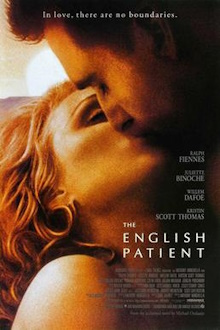I never watch this back in the day and it was never on my watch list. But it popped up while I was browsing Netflix and my wife noted that it was a film she liked. This is a very long film, especially so for a romantic drama, but no can deny the beauty of the cinematography nor how deeply affecting it is. This really has it all, an aristocratic desert explorer who has some serious bad boy vibes, the last gasp of the pre-war internationalist period, all mixed up with passionate love so intense that it overcomes marriage vows and gentlemanly conduct. I have quibbles about its structure and the relevance of characters like Hana and Kip, but it’s a good film that deserves its place among the great romances.
A biplane flying across the desert is shot down and crashes. The badly burned pilot is rescued by Bedouins. He later turns up in Italy, a dying, amnesiac man who is simply called the English Patient. Hana, a French-Canadian nurse, takes care of him but she herself is distraught by the deaths of her boyfriend and her colleague. She decides to leave her hospital unit and care for him by herself at a bombed-out monastery. Flashback scenes reveal the patient’s past. He is actually László Almásy, a Hungarian aristocrat who worked with a Royal Geographical Society group of explorers and surveyors based out of Cairo. When a British couple Geoffrey and Katharine Clifton joins their group, providing an aircraft and funding, he keeps his distance from Katherine. Yet he appears to stalk her and Katherine seems attracted to him despite his deliberate rudeness. Later he discovers the Cave of Swimmers with its rock art and they are trapped together in a sandstorm. They begin a passionate affair, hiding their relationship from Geoffrey even as World War 2 approaches, straining the ties between people of different nationalities and making international cooperation impossible.
The passion between Almásy and Katherine are at the heart of the film but there are plenty of other things going on as well, accounting for the long running time. There’s Hana’s story and how she believes herself to be cursed as her loved ones keep dying and is redeemed only by her own romance with Kip, an Indian sapper. There’s David Caravaggio, a Canadian operative who worked with the Cliftons and dogs Almásy, believing him to be a traitor. I think it’s structurally odd as the pre-war flashback scenes are by far the best part of the film. Yet Hana is only in the present day scenes and doesn’t have much of a relationship with Almásy. Caravaggio is out for vengeance but he never interacts with Almásy before the war either. I think this is because the film was adapted from a novel and the novel is actually a sequel to a previous one in which both Hana and Caravaggio are characters. Still, the inclusion of these side stories contribute to this feeling more like an epic war film, placing their love affair within the context of larger events. They’re everything to each other, but at the same time, it’s just one more story in a middle of tumultuous time when every single person has a story of their own.
Interestingly, László Almásy was a real person but this is a completely fictionalized version of his life. There’s a real fin de siècle feeling in here as the end of the romance between Almásy and Katherine also seems to mark the end of brotherly international cooperation in Africa. But of course that too is romantic fiction as all of them were still just Europeans lording it over the natives. For these reasons, this is a film that I can admire and enjoy but it isn’t one that I would love. It’s too obviously constructed to ramp up the dopamine hit of a dreamy romance. Take this fictional version of Almásy, an exotic foreigner with a vaguely aristocratic background who initially comes across as cold but hides a red hot core of passion. How could women resist catnip like this? It’s not aimed at me though and I struggle to find any deeper meaning in it than what an amazing fantasy romance this would be to live out.
